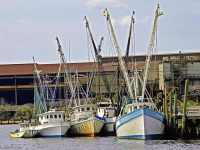HISTORY: Ferries
S.C. Encyclopedia | The earliest ferries in South Carolina carried settlers across the Ashley, Cooper, Santee, and other Lowcountry waterways. Early ferries, sometimes called “boats” or “galleys,” were important for transportation but were frequently poorly constructed, haphazardly manned, and expensive to the everyday traveler.








 We Can Do Better, South Carolina!
We Can Do Better, South Carolina!

























Recent Comments